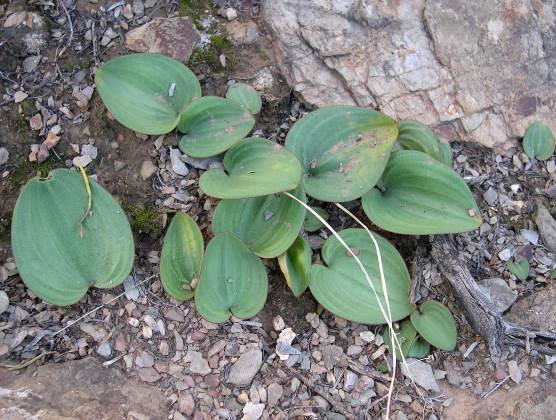Eriospermum

Eriospermum is a monotypic genus of small to medium-sized, tuberous perennials. The family is Ruscaceae, although research might still determine whether Eriospermaceae, Convallariaceae or Asparagaceae is more appropriate.
The stem tubers are globose to irregularly shaped, sometimes growing many stolons or rhizomes. The tubers are white, yellow, pink or purplish red inside. Each above-ground part has a neck consisting of the sheathing fibrous remains of leaf bases.
One or more leaves are grown annually, usually when the plant is not in flower. The mostly stalked leaves are erect or prostrate from the ground, sometimes hairy and sometimes red on the lower surfaces. The highly variable leaf-shape is linear, lanceolate, ovate or round. Some species grow leaf appendages, variable in shape, or the blades are scale-like. The leaf appendices are known as enations.
The inflorescence stem or peduncle is straight, cylindrical, unbranched, naked and usually erect. The inflorescence is a raceme bearing a variable number of flowers, the uppermost buds may not develop. The small flowers each has a bract below its pedicel.
The regular, bisexual flowers are star-shaped or cup-shaped. They have six white, yellow, pink or green tepals that open during daytime. In each flower there are six stamens and a superior ovary that has three locules.
The fruit capsule is ovoid (egg-shaped) or turbinate (top-shaped or obconical), opening its locules separately, the valves persistent. Six to twelve ovoid to comma-shaped seeds covered in white-woolly hairs are produced. These hairs may be up to 8 mm long and may turn brown later.
The generic name, Eriospermum, is derived from the Greek words erion meaning wool and spermum meaning seed, referring to the woolly seed coverings.
There are about 102 Eriospermum species, all in Sub-Saharan Africa and almost all occurring in southern Africa, mostly in the Western Cape. Different species may grow in the same area, flowering at different times by which hybridisation is prevented or minimised. Species identification becomes tricky when leaves are similar, but the flowers are then fortunately usually different, and vice versa.
The Afrikaans common name for eriospermums is bobbejaanui (baboon onion), the baboons probably digging them up as food. People also eat the tubers of certain Eriospermum species.
Some of the plants are cultivated by gardeners. Winter and summer rainfall species will do better in their matching rainfall regions.
The plant in picture is Eriospermum capense subsp. capense. Many or all of the leaves in picture may be rhizome-connected (Leistner, (Ed.), 2000; Vlok and Schutte-Vlok, 2015; Andrew, 2017; https://www.pacificbulbsociety.org; https://keyserver.lucidcentral.org).

